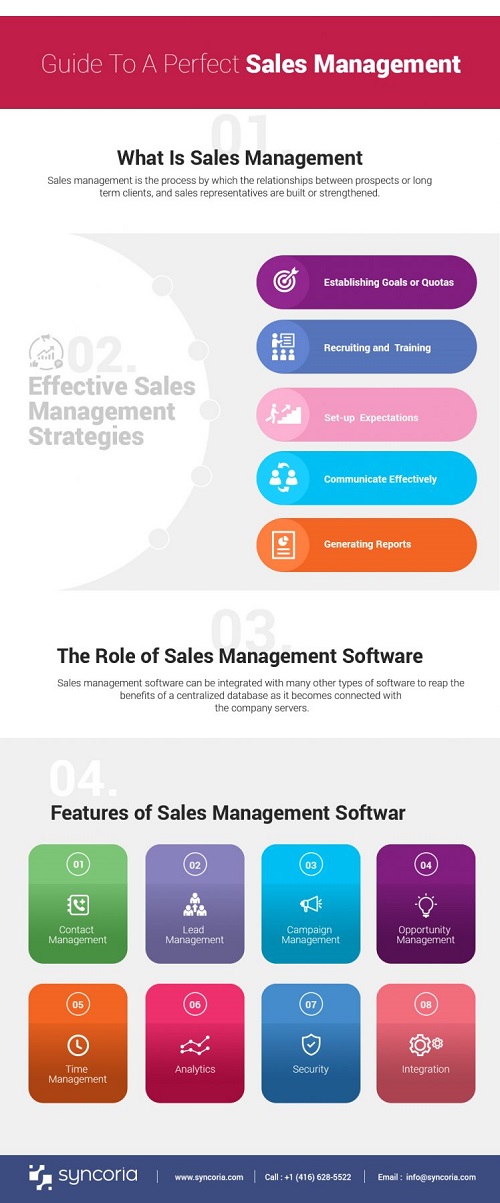Related Articles
In the wake of the Internet of Things (IoT), industry 4.0, and other transformations in all sectors of the economy, companies are increasingly starting to rely on automated systems for a greater analysis of the information at speeds that were never crossed by humans before.
One of the most critical parts of the firm where agility is of the essence is sales. Here, we will look at what sales management is, the tools needed to optimize the process, and the recommended software for sales management.
What is sales management?

Sales management is the process by which the relationships between prospects or long term clients and sales representatives are built or strengthened, leading to better and more deals being closed.
Sales management is a department closely interlinked with other departments of the firm, such as marketing, production, customer care, and support, supply chain management, etc.
This is because all of their strategies for improvement, especially marketing, rely heavily on the ability of satisfied customers purchasing products repeatedly, or potential customers going past the point of conversion.
The team structure of any sales management includes sales managers, assistant sales managers, team leaders, and other sales personnel.
Sales management is, therefore, a team effort led by an ambitious and diligent mentor who was previously a sales rep.
Thus, it requires not only a productive and smart manager but other tools and services to make the lives of these people a lot easier.
Each sales manager creates a list of objectives or targets that must be reached within a given amount of time.
Through this, salespeople are directly involved in creating and implementing any future directives or methodologies of the company, under the supervision of either their leader or the manager himself.
Effective sales management strategies
These are five tips from experienced sales managers that are guaranteed to generate a fastidious taskforce:
- Establishing goals or quotas: For the team and for individual reps, there should be separate goals and quotas set to maintain a high standard of marketing. There can be many different types of goals, such as finishing an activity, setting up a specific job function, completing a training module, etc. Make sure people in higher management and other corporate affiliates of the sector are aware of the goals being set. Otherwise, there is confusion about the duties expected of the reps.
- Recruiting and training: Hiring and onboarding recruits is a continuous process in this sector, and it is essential that a constant stream of capable individuals hired, as sales rep turnover is very high regardless of which industry it is. Thus, individuals are on a level playing field where the platform for starting the job is more equitable since people have the same amount of knowledge. Trainees or interns can learn how to close deals faster, how to convert a prospect, and even understand the technology used to chat or communicate with other team members. Conversations with potential customers and analyzing buyer personas become important to teach.
- Set up expectations: A crucial aspect, accurate expectations of reps, allow these people to work accordingly without either slacking off or overworking themselves. Commission rates, possible salary rates, and fluctuations are all vital components to consider when introducing a new employee to the field. The downside of not doing this is employees prioritizing the wrong prospects. He was spending too much time on one and too little on another. It could result in a loss of valuable customers who have propelled the growth of the firm for a long time. By consulting human resources and other higher-ups of the firm, compensation plans can be set up for employees after taking considerations of future plans of the company.
- Communicate effectively: Communicating well with higher up and representatives ensures that efficiency is guaranteed, and the process of initiating and completing a product life cycle is much faster. Upper management may include senior managers, directors, executives, etc. Acting as a liaison between these two groups guarantees that there is an advocate for salespeople, and also so that the reps know what is expected of them. Senior managers may be informed of details of improvement by receiving feedback from customers, any necessary brand feedback, and positive and negative testimonials that serve as evidence for a change in marketing strategy. Reps may be informed of new services or goods being launched or any relevant information about investors or revenue that the directors want to share for better company-wide growth.
- Generating reports: Various types of reports may be constructed and does not have to be bound to sales only, as revenue reports can also be prepared. Assessing individual reps and the holistic performance of the team gives an outlook on the areas of improvement and hierarchical changes that need to be made. Statistics such as which products are sold more frequently, how quickly deals are closed by certain reps, which assets are most used to convert prospects to customers are obtained by automated means. Thus, this information can be made available to reps with the anonymity of the senior members being maintained to increase productivity.
By motivating reps and adapting the sales process in these five ways, sales management can be an easy, customizable and flexible portion of the corporation with only a small amount of resources being used to produce valuable information.
The role of sales management software
Sales management software is, by definition, an operating system designed to automate and streamline much of the data needed for sales teams.
Collating the data allows daily activities of sales reps to be recorded and their pipelines or prospects to be monitored.
The greater the number of deals closed, the more team wins can be achieved.
Hence, by planning, staffing, and executing different plans, opportunities for improvement can be explored by sales teams as different tasks can be automated, and different jobs are tracked.
Sales management software can be integrated with many other types of software to reap the benefits of a centralized database as it becomes connected with the company servers.
It saves time in all parts of the process and allows menial tasks to be done quickly.
It removes the hassle of manual entry, the traditional way of updating and maintaining data, resulting in reps being able to focus on other, more important tasks.
Important features of sales management software
A number of features are necessary to create an adaptable and smoothly working system to be set up.
The goal is to be able to visualize the sales pipeline – lead generation, lead qualification, sales opportunity conversion, and deal closure – and to fulfill that vision and make it a reality.
The benefits are quite intuitive and important for an industry that is increasingly becoming more mechanized.
Thus, learning to optimize such digital frameworks depending on the industry and your competitors has become a modern way of creating wider profit margins.
- Contact management: Coherent and easygoing interactions between people are important. Customer data, such as contact numbers, email addresses, relevant references, fax numbers, call history, activity tracking, age, and other data related to demographics, must be stored and arranged in a centralized destination. Retrieval and analysis of this information in the right place becomes important for determining the future line of the company.
- Lead management: This branch covers the sales activity, the distribution of leads among sales reps, the number of prospects, the conversion rate, and the number of deals closed. Additionally, it can be connected to a contact management system as a separate module in the main software. Lead generation and qualification are directly involved in this as the nurturing, capturing and conversion of a lead after its genesis and assignment are at the heart of the sales process.
- Campaign management: Campaign management is about setting up target audiences or groups, creating projects catered towards their specified dimensions of the service, motoring through the work process, and measuring success on a predefined non-arbitrary metric. This often involves the integration and monitoring of pages on social media platforms, such as likes, dislikes, shares, reviews, and comments, to get feedback from customers directly. Email services, such as checking unopened emails, drafts, sent mail, spam, and clicked emails are also important and must be connected with clients such as Microsoft Outlook, Gmail, Yahoo Mail, etc.
- Opportunity management: While lead management is associated with definitive leads, opportunity management deals with potential sales offers and prospective clients, which increases the number of customers. Through pipeline management, quote management, and order management, such individuals can be persuaded to purchase goods from the firm.
- Time management: One of the most significant benefits of using software is to reduce the average closure time and response time of sales reps. This creates more customer satisfaction as it gives off the impression that the firm is not disinterested in selling you the product. This also helps workers to be more productive as their daily work schedule is organized in a way to fit in as many tasks as possible to maximize work done. Meetings with potential leads, new recruits for sales, or with upper management are all arranged and notified using calendar invites, task scheduling, and document or spreadsheet management and storage. Furthermore, collaboration tools with other members allow a confirmable workflow, so there is no interruption except for compulsory breaks for leisure for recovery of energy.
- Analytics: In the first tunnel, most executives and directors of the organization want to know where leads might go. This helps them make more astute predictions and allows a greater degree of scrutinized speculation for investors and shareholders. Analyzing areas where there is most revenue, avenues of subpar communication, business response time, and others are crucial in understanding the pragmatic direction of the company. Using charts, graphs, histograms, and diagrams, all of this data can be filtered and centrifuged to assemble and visualize a proper sales campaign. This is helpful for sales forecasting, real-time reporting, and pipeline reports.
- Security: Safety and security are top-notch concerns of a firm, as leaks of company data can lead to massive charges of espionage, leading to a negative reputation and bad PR circulating in the industry. A secure firewall and other encryption methods must be used to protect this data. This may be deployed using the advice of top-notch tech consultants. Restricting access to certain files by requiring administrative permissions or log-ins is a way to keep classified information sealed.
- Integration: Last but not the least, the ability to integrate with other services or software such as email, marketing, purchasing, inventory or warehouse, CRM, etc. is what makes the firm more dynamic and flexible. With customer relationship management or CRM software, especially, the collectivized data pool is crucial in identifying trends or patterns among customers and changing the specifics of the product or the marketing accordingly. Mobile integration is also important to allow notifications to reach users whenever and wherever they are, along with with APIs and social media integration to form one large platform.
Advanced features may include gamification, sales order management, a module on accounting and finance, etc.
All of these features may be grouped into separate modules, and the availability of the additional features relies on the settings or the template of the software. It is up to you to modify the software as you see fit.
There is much software available in the market.
We recommend Odoo. Odoo is a user-friendly business software that provides you with just about every tool you would ever need.
Built under the same UI, Odoo uses one app to do all the jobs in one:
streamlining operations, managing invoicing, and boosting sales.
It has CRM software where the module for sales is included, but just for convenience, it also has a separate software for sales management which is easy to work with.
The system is easy to work with and is connected to the cloud network of Odoo, which has global servers, making it easy to download and upload data at lightning speeds.
Syncoria, a digital transformation company based in Canada, is an official Odoo Ready partner. To contact Odoo, call at +1 (416) 628-5522, or email them at odoo@syncoria.com.




